Etherlords Preview
Etherlords is a turn-based strategy game that should appeal to fans of Magic & Mayhem and Heroes of Might and Magic.
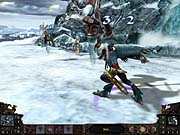
Magic the Gathering might not be as popular as it once was a few years ago when it inspired several computer knock-offs and translations, but its influence can still be seen in games today. Nival Interactive's upcoming strategy game is in essence a cross between Heroes of Might and Magic and Magic the Gathering. This turn-based fantasy game, slated for a November release, is a meld of overland strategic exploration and card-game tactical combat.
In Etherlords, the gameworld is nearing a cosmic change. The balance of power is about to shift, as four factions vie to control the magic energies that power the world. These fours factions have aligned into two groups, one representing chaos and one representing law. The forces of Chaos wish to assault the Tower of the White Lord and claim its powers to reshape the world, but the forces of Law are arraying themselves to stop the chaotic usurpers. As the champion of either alliance, your job is to either usher in a new world order or protect the status quo.
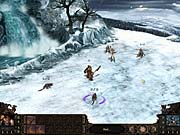
The story may be simple, but it's simply an excuse to indulge in traditional fantasy gameplay. Etherlords is a turn-based strategy game and should appeal to fans of Magic & Mayhem and Heroes of Might and Magic. The concept is simple: control a handful of heroes, explore the map, gather resources, meet enemy heroes, and engage in tactical battles. The game is fairly small scale, and you won't have to manage hordes of troops or even too many heroes. However, there is lots of nuance in the troops you can control and a fairly sophisticated system of creatures and spells reminiscent of Magic the Gathering, complete with the same rules of engagement of that addictive card game.
While the gameplay may be simple, the graphics look like they'll do a good job of pulling in gamers. The game is in 3D and features a wide range of beautiful colors, textures, and many different models for the great variety of creatures in the game. You'll do battle in woods, snow, plains, and barren ground. The terrain in the overland map doesn't compare with the tactical scene, but it does look good. It's in the battle screen, though, where the eye candy is. On the snow terrain, for instance, snow gently drifts down from the sky, while an icy waterfall flows down the side of your screen. The woodlands feature a lush arena of green trees, and the desert has fine sand dunes and detailed columns of rock.
The game is really about throwing creatures at one another, and there is a plethora of fascinating monsters in the game. There are insects, plants, cyborgs, dragons, birdmen, and more. And they all sport detailed textures, fluid and realistic animation, and a genuinely unique look from faction to faction. Sound is also shaping up to be good, with lots of ambient noises for the creatures and your heroes.
So while the game itself might be something more akin to the 2D, turn-based world of Heroes, the visuals are more in line with the real-time 3D games of today, such as Sacrifice and Battle Realms. It's the focus that is different, harking back to a simpler type of gameplay.
The Strategic Game
Etherlords is very much a union of two styles of gameplay: strategic exploration and card-game-inspired tactical combat. Like in New World Computing's Heroes of Might and Magic series, you control hero units by moving them around an overland map, collecting resources and capturing mines. Your home base is your castle, but it is an inert structure. You don't build structures or recruit units there. In fact, your castle does nothing but represent your vitality in the gameworld. If it is destroyed, you lose the game.
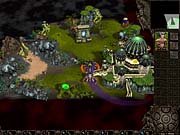
When you begin play, you start out with a handful of heroes near your castle. You then use them to explore the map. Scattered about the map are mines, lumps of free resources, neutral buildings, and hostile monsters. There are eight resources in Etherlords: mandrake root, black lotus, blood ruby, poison emerald, star sapphire, smoke diamond, frozen flame, and mana. It's an overabundant array of resources, although it appears that you'll need mandrake root and black lotus in greater amounts than the other resources, which are more like secondary resources to fuel high-level spells. All of these resources, except for mana, can be accumulated by controlling the appropriate mines on the map. In addition to mines, you'll find labs of varying power, such as apprentice and sorcerer labs. Here, you can buy new spells to supplement or replace the spells in your deck. There are also huts where you can learn new skills for your heroes, gain free experience, or gain more mana. Also peppering the landscape are loitering monsters, waiting to fight you and give you experience if you kill them.

A large part of the game involves composing your deck of spell cards. Like in Magic the Gathering, your heroes carry around a deck of spells. These spells are the source of your hero's power. With them, he summons creatures to fight for him and casts spells to make his creatures better. During battle, you can't adjust your deck of spell cards, but in the overland map, you can. You'll visit the various labs, and there, you can buy new cards to enhance your existing deck. Each of the four factions has a preset deck of simple creatures and simple enhancement spells. You can then visit labs to buy new and better spells. However, these spells carry a repeating resource cost. Not only do you need to pay at the lab to get knowledge of the spell, but you also have to pay to add each card to your deck. It's an expensive endeavor to continually update and expand your deck, especially because payment is on a per-usage basis, but it's necessary, as the game quickly escalates in power as you advance through the single-player campaign or in single missions against the AI or humans.
As mentioned above, unlike Heroes, there is no town management. Neither are there town sieges. You cannot directly assault an enemy castle. But, with the game's global spells, you can invade an enemy castle through the Ether that surrounds the gameworld. The Ether is apparently a magical plane that mirrors the physical world. Much of the world's magic is drawn from the Ether. Translated into gameplay, you can cast global enchantments during your turn, and they can affect the gameworld. Some of these global spells let you spy on enemy heroes, explore the map, summon new heroes, and create temporary fortifications out of thin air. One global spell called "warrior of the realm" is crucial to winning the game. This spell, once cast, lets you send your hero through the Ether to attack the enemy castle. Your best hero and the enemy's best hero then square off at the doorsteps of his castle. If you win the battle, you don't kill the enemy hero. Instead, you damage the enemy castle. Win enough of these battles, and you'll destroy the castle and win the game.
A Mix of Card Games and RPGs
When you encounter a hostile monster or an enemy hero, or when you invade an enemy castle through the Ether, a tactical battle ensues. The screen changes to a zoomed-in view of the terrain and your hero and the enemy villain. Etherlords is a battle of individuals, so whether you are fighting neutral monsters or enemies, you are always pitting one of your heroes against one enemy. In essence, the Etherlords battlefield is more a one-on-one showdown than a clash of troops.
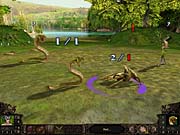
Immediately, you will notice that this game does not play like other strategy games. It's a thinly disguised Magic the Gathering clone. The goal of each tactical battle is to destroy the enemy hero, but heroes cannot directly engage in battle. Instead, they must summon monsters to act on their behalf. Each turn, you get a slowly increasing amount of mana. With this mana, you can pay to activate cards from your deck. Your deck of spell cards is shuffled randomly before each battle, so you never know exactly which hand you'll have when battle begins. You start with six cards in your hand and gain a new card each turn. The cards are varied and include creature summons, direct attack spells, and spells that enhance your summoned creatures.
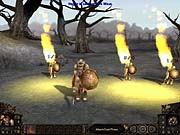
The interface is simple and the commands straightforward. In each turn, you can cast spells, direct your creatures to attack, or wait. That's it. If you make your creatures attack, your opponent then gets to designate blockers to deflect your onrushing creatures. However, just as in Magic, if your creatures attack during your turn, they are unavailable to block for you when it's your opponent's turn to attack. These creatures are, in the parlance of collectible card games, "tapped." In some instances, certain cards have special abilities, like "flying," that are always on, and other abilities, like resurrecting units, that are activated only when you "tap" the creature, meaning you sacrifice their action for the execution of the desired ability.
Combat is actually stimulating and challenging and requires lots of tactical thought. However, perhaps even more important than your performance on the battlefield is how you compose your deck before battle. As Magic players know, creating your deck is a strategic challenge that requires lots of forethought and planning. You don't want to load your deck with too many creatures that have high mana costs, because you could be creatureless while you wait for your mana to accumulate. Conversely, you don't just want an army of low-level creatures because those are easily foiled. You also have to give careful thought to how many noncreature cards you want in your deck. You want a fair amount of creature-enhancing spells, but at the same time, since your creatures do the brunt of the work, you don't want to have too many noncreature spells displacing valuable space in your deck. Because your deck has a finite amount of space for your cards, composing your deck can be a real challenge.
When you win in battle, you gain experience points, which in turn let you advance in level. Each time you gain a level, you add more hit points to your hero and get to select a new skill. These skills can include being able to buy spells for fewer resources, activating spells in combat for less mana, gaining more than one card per turn in battle, and more. There also appears to be different ranks within each skill. For instance, the concentration skill lets you draw an additional card during combat. At the first rank, you can draw a card every third turn. If you level up again and choose to specialize further in the concentration skill, you can then draw a card every two turns. And so on.
The Factions
Etherlords, like all good strategy games, will offer a bevy of creatures and heroes to satisfy the different tastes of gamers. There are dozens of different creature types to summon and control, from treants to dragons to undead. All the creatures are organized by faction, with each faction representing a different ideal in the world of Etherlords. The two factions that promote chaos are the Chaots and Synthets, while the two that promote order are Kinets and Vitals. Here is a brief overview of the factions:
Chaots
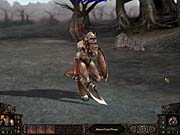
Synthets
As its name implies, this faction represents the unnatural melding of man and machine. This faction features a variety of biomechanical creatures, worms, and starfishes, for example, but they all are composed of metal and vestigial organic parts. There are also more futuristic creatures, such as cyborgs and bipedal robots with long, sharp fins protruding from their arms. The creatures from this faction have an unusual array of special abilities, like the worms that can attack immediately after being summoned, unlike other creatures that must wait a turn after being summoned before they can act.
Kinets
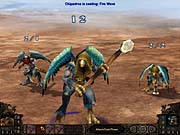
The Kinets faction represents goodness and order. Its heroes are dressed in shining armor and appear the most humanlike. Hawklike humanoids named the aviaks make up the brunt of its army. The Kinets also have ghosts and apparitions on their side. The ghosts are called walls, and they protect the Kinets hero from enemy creatures, while the apparitions include wizards and priests, who have unusual abilities in addition to their standard attacks. Many of their creatures have the flying ability, which means only other flying creatures can block them.
Vitals
The Vitals are a faction that lives in harmony with nature. Their heroes are scantily clad or dressed in leaves and green clothing. As guardians of nature, the Kinets summon many creatures of the forest, including bees, ticks, hornets, carnivorous plants, and treants. They also have spells that promote vitality and life, such as healing spells and mana spells that give one-time grants of bonus mana.
There is significant variety in the different types of creatures in Etherlords, but even within each creature line, like dragons, there are different ranks to the creatures. Treants, for example, boast low-level representatives like the treant saplings, as well as regular treants and more powerful treant elders. The game will be shipping in a few weeks, so gamers will have their own opportunities to explore and see for themselves how much depth Etherlords has to offer.
Fans of traditional turn-based games should appreciate the simplicity and elegance of Etherlord's design. And if they enjoy the mechanics of collectible card games, they should enjoy the tactical battles of this game as well. While Etherlords eschews the conventions of recent strategy games, its more traditional approach could be just what fans of turn-based strategy games are looking for.
Got a news tip or want to contact us directly? Email news@gamespot.com
Join the conversation